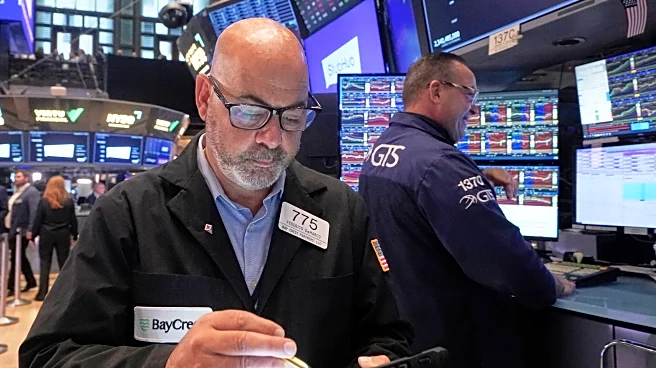What's Happening?
The U.S. stock index futures, particularly those tied to the S&P 500 and Nasdaq, reached record highs following the Federal Reserve's decision to cut interest rates by a quarter-point. This marks the first rate cut of the year by the central bank. Federal Reserve Chair Jerome Powell emphasized the importance of addressing the softening jobs market, suggesting that further rate reductions could occur in upcoming meetings in October and December. Despite the rate cut, Powell cautioned against aggressive easing, describing the move as a risk management strategy rather than a rapid response to economic conditions. The decision has contributed to a rally in Wall Street, with the S&P 500 and Nasdaq experiencing multiple sessions of intraday record highs.
Why It's Important?
The Federal Reserve's decision to cut interest rates is significant as it impacts various sectors of the U.S. economy. Lower interest rates generally encourage borrowing and investment, potentially stimulating economic growth. This move is particularly beneficial for small-cap companies, which tend to perform better in low interest-rate environments. The rate cut also reflects the central bank's focus on managing risks associated with a weakening labor market. Investors are closely monitoring these developments, as further rate cuts could influence market dynamics and economic forecasts. The decision also highlights the Fed's independence, as attempts by President Trump's administration to influence the central bank's decisions were unsuccessful.
What's Next?
Looking ahead, the Federal Reserve may consider additional rate cuts if data continues to show signs of a persistent soft labor market. The central bank's future policy easing will be contingent on economic indicators supporting the need for further intervention. Market participants are pricing in potential cuts by the end of 2025, indicating expectations for continued monetary policy adjustments. Additionally, the upcoming weekly jobless claims report will provide further insights into the labor market's condition, potentially influencing the Fed's decisions in the near term.
Beyond the Headlines
The interest rate cut by the Federal Reserve also raises questions about the long-term implications for inflation and economic stability. While lower rates can boost economic activity, they may also lead to increased inflationary pressures if not managed carefully. The Fed's approach to balancing these factors will be crucial in maintaining economic health. Furthermore, the decision underscores the importance of central bank independence in navigating complex economic challenges without political interference.












